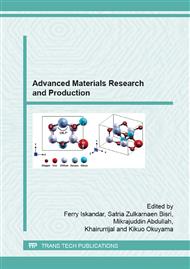p.279
p.282
p.286
p.290
p.294
p.299
p.303
p.308
p.313
Phase Analysis of Natural Silica-Sand-Based Composites as Potential Fuel-Cell Seal Material
Abstract:
Seal is one of the most important components in fuel cells which is required to bond the cell stacks and prevent mixing of gases in electrodes. Some of the requirements for such components are able to seal several adjacent cell components, which means compatible in thermal expansion coefficient values, and need to be chemically stable in a long-term operation. In this study, the potential use of natural silica sands from Bancar and Sowan in Tuban, East Java, Indonesia was explored, particularly from phase composition point of view. Six batches of samples were collected from both sites. X-Ray Fluorescence (XRF) and X-Ray Diffraction (XRD) data from all samples were complementarily used in this study. XRF and XRD data for each sample showed that quartz (SiO2) was the most dominant phase, with estimated Rietveld method-based weight fraction content ranged between 70.1 and 98.7%. The second dominating phase is calcite (CaCO3). According to the results obtained, we found that there is a slightly difference in the value of phases weight fraction due to RIR and Rietveld methods. In this research, PB-01 sands mixed with 17 wt.% magnesia and were calcined at various temperatures. Natural silica-sand-based composite may give promising excellent candidate for seal fuel cell material, because it forms forsterite and enstatite which suit the CTE value of sealant of fuel cell.
Info:
Periodical:
Pages:
294-298
Citation:
Online since:
July 2015
Keywords:
Price:
Сopyright:
© 2015 Trans Tech Publications Ltd. All Rights Reserved
Share:
Citation:


